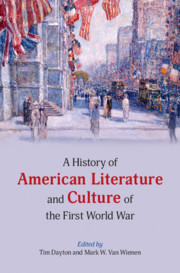Book contents
- A History of American Literature and Culture of the First World War
- A History of American Literature and Culture of the First World War
- Copyright page
- Contents
- Figures
- Contributors
- Acknowledgments
- Introduction America’s Great War at One Hundred (and Counting)
- Part I Genre and Medium
- Part II Settings and Subjects
- Part III Transformations
- Chapter 22 The Nation
- Chapter 23 Free Speech
- Chapter 24 Labor
- Chapter 25 The Veteran
- Chapter 26 The Military-Industrial Complex
- Chapter 27 The World
- References
- Index
Chapter 27 - The World
Race, Red-Baiting, and the Wilsonian Century
from Part III - Transformations
Published online by Cambridge University Press: 23 January 2021
- A History of American Literature and Culture of the First World War
- A History of American Literature and Culture of the First World War
- Copyright page
- Contents
- Figures
- Contributors
- Acknowledgments
- Introduction America’s Great War at One Hundred (and Counting)
- Part I Genre and Medium
- Part II Settings and Subjects
- Part III Transformations
- Chapter 22 The Nation
- Chapter 23 Free Speech
- Chapter 24 Labor
- Chapter 25 The Veteran
- Chapter 26 The Military-Industrial Complex
- Chapter 27 The World
- References
- Index
Summary
This chapter explores the mutually reinforcing transformations in American state-society and foreign relations engendered by the First World War and its aftermath. Scholars have long recognized the war as a critical event in the emergence of American global power and the concomitant rise of Wilsonian liberal-internationalism. Yet it is the post-World War II period that is typically designated as the decisive moment of epochal rupturing in US history. This chapter seeks to problematize these notions of a sharp epochal break, demonstrating the more fluid lines of continuity between the two periods contextualized within the longue durée of American state-formation. In particular, it highlights the ideo-political and cultural antecedents to Wilson’s liberal internationalist order-building project and its relationship to the defence of white supremacy at home and abroad. In so doing, the chapter demonstrates how the post-1945 US-led Western liberal international order was built upon white supremacist foundations and a particular form of racialized anti-communism that had emerged decades earlier. US hegemonic practices were, on this view, constituted in and through the racial articulation of an anti-communist “common sense” defined by a militantly normative Americanism that found its roots in the First World War period.
Keywords
- Type
- Chapter
- Information
- Publisher: Cambridge University PressPrint publication year: 2021
- 1
- Cited by

